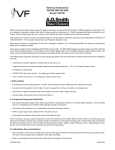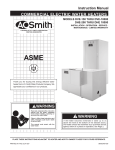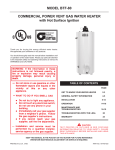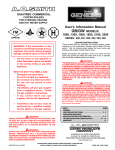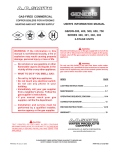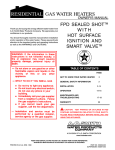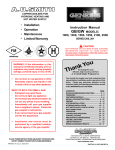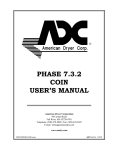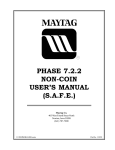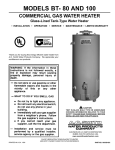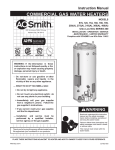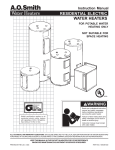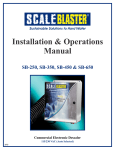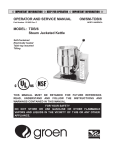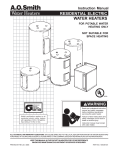Download s manual - AO Smith Water Heaters
Transcript
RESIDENTIAL GAS WATER HEATER OWNER'S MANUAL GPDH/GPDT/GPDX GAS MODELS Thank you for buying this energy efficient water heater from A.O. Smith Water Products Company. We appreciate your confidence in our products. with Hot Surface Ignition You should thoroughly read this manual before installation and/ or operation of this water heater. Please pay particular attention to the important safety and operating instructions as well as the WARNINGS and CAUTIONS. TABLE OF CONTENTS PAGE GET TO KNOW YOUR WATER HEATER ...................... 2 GENERAL SAFETY INFORMATION ............................. 3 INSTALLATION ....................................................... 3-11 LIGHTING AND OPERATING LABEL ......................... 12 OPERATION .......................................................... 13-14 MAINTENANCE AND TROUBLESHOOTING ........................................... 14-18 WARRANTY ................................................................ 19 CAUTION TEXT PRINTED OR OUTLINED IN RED CONTAINS INFORMATION RELATIVE TO YOUR SAFETY. PLEASE READ THOROUGHLY BEFORE INSTALLING AND USING THIS APPLIANCE. A DIVISION OF A.O. SMITH CORPORATION www.aosmithwaterheaters.com KEEP THIS MANUAL IN THE POCKET ON HEATER FOR FUTURE REFERENCE WHENEVER MAINTENANCE ADJUSTMENT OR SERVICE IS REQUIRED. PART NO. 184707-001 PRINTED IN U.S.A. 0805 1 GET TO KNOW YOUR WATER HEATER A B C D E F G REPLACEMENT PARTS AND DELIMING PRODUCTS Replacement parts and recommended delimer may be ordered through authorized servicers or distributors. Refer to the Yellow Pages for where to call or contact the A.O. Smith Water Products Company, 125 Southeast Parkway, Franklin, TN 37068, 1-800-433-2545. When ordering parts, provide complete model and serial numbers (see rating plate), quantity and name or part desired (as listed in Figure 1). Standard hardware items may be purchased locally. H J K VENT PIPE-EXHAUST ANODE HOT WATER OUTLET OUTLET (115 V. AC) FLUE BAFFLE GAS SUPPLY MAIN MANUAL GAS SHUT OFF VALVE GROUND JOINT UNION DIRT LEG OUTER DOOR L M N O P Q R S T U V W X Y Z AA BB CC UNION INLET WATER SHUT OFF VALVE COLD WATER INLET INLET DIP TUBE TEMPERATURE AND PRESSURE RELIEF VALVE RATING PLATE INSULATION VENT TERMINAL EXHAUST DRAIN VALVE HSI ASSEMBLY FLUE DRAIN PAN GAS VALVE CONTROL HARNESS INTAKE AIR PIPE VENT TERMINAL INTAKE INNER DOOR BURNER ASSEMBLY TEMPERATURE INDICATORS X TEMPERATURE ADJUSTMENT BUTTONS TYPICAL NATURAL GAS PILOT & MAIN BURNER U CC HOT SURFACE IGNITION ASSEMBLY U CERTAIN MODELS ARE EQUIPPED WITH SIDE PLUMBING CONNECTIONS FOR SPACE HEATING. HOT AND COLD FITTING ASSEMBLIES PART NO. 900126-2. * CAUTION: 115VAC IN CONTROL HARNESS AND INSIDE JACKET GAS MODEL GPDH/GPDT/GPDX WITH HOT SURFACE IGNITION FIGURE 1. 2 WARNING Should you choose to apply an insulation blanket to this heater, you should follow these instructions, see Figure 1 for identification of components mentioned below. Failure to follow these instructions can restrict the air flow required for proper combustion, potentially resulting in fire, asphyxiation, serious personal injury or death. GENERAL SAFETY INFORMATION EXTERNAL DAMAGE Do not operate the water heater until it has been fully checked out by a qualified technician, if the water heater: • Has been exposed to fire or damage. • Displays evidence of sooting. • Do not cover the outer door, thermostat or temperature & pressure relief valve. • Do not cover the instruction manual. Keep it on the side of the water heater or nearby for future reference. • Do obtain new warning and instruction labels from A.O. Smith for placement on the blanket directly over the existing labels. • Produces steam or unusually hot water. If the water heater has been flooded it must be replaced. CHEMICAL VAPOR CORROSION LIQUID PETROLEUM MODELS WARNING CORROSION OF THE FLUEWAYS AND VENT SYSTEM MAY OCCUR IF AIR FOR COMBUSTION CONTAINS CERTAIN CHEMICAL VAPORS WHICH WILL BREAK DOWN INTO ACIDS AT HIGH TEMPERATURE. SUCH CORROSION MAY RESULT IN FAILURE AND RISK OF ASPHYXIATION. WARNING Water heaters for propane or liquefied petroleum gas (LPG) are different from natural gas models. A natural gas heater will not function safely on LP gas and no attempt should be made to convert a heater from natural gas to LP gas. LP gas must be used with great caution. It is highly explosive and heavier than air. It collects first in the low areas making its odor difficult to detect at nose level. If LP gas is present or even suspected, do not attempt to find the cause yourself. Go to a neighbor’s house, leaving your doors open to ventilate the house, then call your gas supplier or service agent. Keep area clear until a service call has been made. Spray can propellants, cleaning solvents, refrigerator and air conditioning refrigerants, swimming pool chemicals, calcium and sodium chloride (water softener salt), waxes, and process chemicals are typical compounds which are potentially corrosive. Do not store products of this sort near the heater. Also, air which is brought in contact with the heater should not contain any of these chemicals. If necessary, uncontaminated air should be obtained from remote or outside sources. The limited warranty is voided when failure of water heater is due to a corrosive atmosphere. (Refer to the limited warranty for complete terms and conditions). At times you may not be able to smell an LP gas leak. One cause is odor fade, which is a loss of the chemical odorant that gives LP gas its distinctive smell. Another cause can be your physical condition, such as having a cold or a diminishing sense of smell with age. For these reasons, the use of a propane gas detector is recommended. EXTENDED NON-USE PERIODS IF YOU EXPERIENCE AN OUT-OF-GAS SITUATION, DO NOT TRY TO RELIGHT APPLIANCES YOURSELF. Ask your LP delivery person to relight pilots for you. Only trained LP professionals should conduct the required safety checks in accordance with industry standards. WARNING HYDROGEN GAS CAN BE PRODUCED IN A HOT WATER SYSTEM SERVED BY THIS HEATER THAT HAS NOT BEEN USED FOR A LONG PERIOD OF TIME (GENERALLY TWO WEEKS OR MORE). HYDROGEN GAS IS EXTREMELY FLAMMABLE. To reduce the risk of injury under these conditions, it is recommended that the hot water faucet be opened for several minutes at the kitchen sink before using any electrical appliance connected to the hot water system. If hydrogen is present, there will probably be an unusual sound such as air escaping through the pipe as the water begins to flow. THERE SHOULD BE NO SMOKING OR OPEN FLAME NEAR THE FAUCET AT THE TIME IT IS OPEN. INSTALLATION REQUIRED ABILITY INSTALLATION OR SERVICE OF THIS WATER HEATER REQUIRES ABILITY EQUIVALENT TO THAT OF A LICENSED TRADESMAN IN THE FIELD INVOLVED. PLUMBING, AIR SUPPLY, VENTING AND GAS SUPPLY ARE REQUIRED. INSULATION BLANKETS Insulation blankets available to the general public for external use on gas water heaters are not necessary with A.O. Smith products. The purpose of an insulation blanket is to reduce the standby heat loss encountered with storage tank water heaters. Your A. O. Smith water heater meets or exceeds the National Appliance Energy Conservation Act standards with respect to insulation and standby loss requirements, making an insulation blanket unnecessary. GENERAL The installation must conform to these instructions and the local code authority having jurisdiction. In the absence of local codes, the installation must comply with the current editions of the National Fuel Gas Code, ANSI Z223.1/NFPA 54 and the National Electrical Code, NFPA 70. The former is available from the 3 Canadian Standards Association, 8501 East Pleasant Valley Road, Cleveland, OH 44131, and both documents are available from the National Fire Protection Association, 1 Batterymarch Park, Quincy, MA 02269. CAUTION In cold climates provide protection against freeze-up. THE HEATER SHOULD BE LOCATED IN AN AREA WHERE LEAKAGE OF THE TANK OR CONNECTIONS WILL NOT RESULT IN DAMAGE TO THE AREA ADJACENT TO THE HEATER OR TO LOWER FLOORS OF THE STRUCTURE. The appliance, when installed, must be electrically grounded in accordance with local codes or in the absence of local codes with the current edition of the National Electrical Code, ANSI/NFPA 70. When such locations cannot be avoided, a suitable drain pan should be installed under the heater, see Figure 1. The pan should have a minimum length and width of at least 2 inches (51mm) greater than the diameter of the heater and should be piped to an adequate drain. Drain pans suitable for these heaters are available from your dealer or A. O. Smith Water Products Company, 5621 W. 115th Street, Alsip, Illinois 60803. LOCATION OF HEATER The heater is design certified by the Canadian Standards Association for installation with the following minimum clearances between the water heater and combustible and noncombustible construction are: 0 inches from side, 0 inches from back, 6 inches (152 mm) from front of jacket to closet door and 12 inches (30.5 cm) from top of jacket to combustible and non-combustible material. Minimum vent clearance: 0 inches. Provide 24 inches (61 cm) front clearance for servicing and adequate clearance between the jacket top and ceiling for servicing the flue area. Also see clearance for venting on pages 6 & 7. WARNING DO NOT INSTALL THIS WATER HEATER DIRECTLY ON A CARPETED FLOOR. A FIRE HAZARD MAY RESULT. Instead the water heater must be placed on a metal or wood panel extending beyond the full width and depth by at least 3 inches (76.2mm) in any direction. If the heater is installed in a carpeted alcove or closet, the entire floor shall be covered by the panel. Also, see DRAINING. WARNING FAILURE TO HAVE REQUIRED CLEARANCES BETWEEN WATER HEATER AND COMBUSTIBLE MATERIAL WILL RESULT IN A FIRE HAZARD. WATER CONNECTIONS Adequate clearance for servicing this appliance should be considered before installation, such as changing the anodes, etc. Refer to Figure 1 for typical installation. A suitable pipe thread sealant must be used to prevent leakage. WATER (POTABLE) HEATING AND SPACE HEATING Installation: Do not install water heater where flammable products will be stored or used unless the main burner and pilot flames are 1. All piping components connected to this unit for space heating applications shall be suitable for use with potable water. 2. Toxic chemicals, such as those used for boiler treatment, shall NEVER be introduced into this system. 3. This unit may NEVER be connected to any existing heating system or component(s) previously used with a non-potable water heating appliance. 4. When the system requires water for space heating at temperatures higher than required for domestic water purposes, a tempering valve must be installed. Please refer to Figure 2 for suggested piping arrangement. at least 18" above the floor. This will reduce, but not eliminate, the risk of vapors being ignited by the main burner or pilot flame. When installing the heater, consideration must be given to proper location. Location selected should be as close to the wall as practicable and as centralized with the water piping system as possible. FIGURE 2. 4 CLOSED WATER SYSTEM A closed system will exist if a back-flow preventer (check valve), pressure reducing valve, or other similar device is installed in the cold water line between the water heater and the street main (or well). Excessive pressure may develop due to the thermal expansion of heated water causing premature tank failure or intermittent relief valve operation. This type of failure is not covered by the limited warranty. An expansion tank may be necessary in the cold water supply to alleviate this situation, see Figure 1. Contact the local plumbing authority. BEFORE PLACING THE HEATER IN OPERATION, CHECK FOR GAS LEAKAGE. USE SOAP AND WATER SOLUTION OR OTHER MATERIAL ACCEPTABLE FOR THIS PURPOSE. DO NOT USE MATCHES, CANDLES, FLAME OR OTHER SOURCES OF IGNITION TO LOCATE GAS LEAKS. RELIEF VALVE (P)- See FIGURE 1. If the temperature and pressure relief valve on the appliance discharges periodically, this may be due to thermal expansion in a closed water supply system. Contact the water supplier or local plumbing inspector on how to correct the situation. Do not plug the temperature and pressure relief valve. A NEW TEMPERATURE AND PRESSURE RELIEF VALVE COMPLYING WITH THE STANDARD FOR RELIEF VALVES AND AUTOMATIC GAS SHUT OFF DEVICES FOR HOT WATER SUPPLY SYSTEMS, ANSI Z21.22 (CURRENT EDITION) MUST BE INSTALLED IN THE HEATER IN THE MARKED OPENING PROVIDED. THE VALVE MUST BE OF A SIZE (INPUT RATING) THAT WILL BE ADEQUATE FOR YOUR SIZE HEATER. GAS CONNECTIONS The minimum gas supply pressure for input adjustment is 5.0" W.C. (1.25 kPa) for natural gas 11.0" W.C. (2.74 kPa) for propane. Check the metal tag on the relief valve and compare it to the heater’s rating plate. The pressure rating of the relief valve must not exceed the working pressure shown on the rating plate of the heater. In addition, the hourly Btu rated temperature steam discharge capacity of the relief valve shall not be less than the input rating of the heater. NO VALVE IS TO BE PLACED BETWEEN THE RELIEF VALVE AND TANK. DO NOT PLUG THE RELIEF VALVE. THE HEATER IS NOT INTENDED FOR OPERATION AT HIGHER THAN 10.5" (2.6 kPa) FOR NATURAL & 13.0" (3.24 kPa) FOR PROPANE WATER COLUMN SUPPLY PRESSURE. EXPOSURE TO HIGHER GAS SUPPLY PRESSURE MAY CAUSE DAMAGE TO THE CONTROL WHICH COULD RESULT IN FIRE OR EXPLOSION. If overpressure has occurred such as through improper testing of gas lines or emergency malfunction of the supply system, the control must be checked for safe operation. Make sure that the outside vents on the supply regulators and the safety vent valves are protected against blockage. These are parts of the gas supply system not the heater. Vent blockage may occur during ice storms. The drain line connected to this valve must not contain a reducing coupling or other restriction and must terminate near a suitable drain to prevent water damage during valve operation. The discharge line shall be installed in a manner to allow complete drainage of both the valve and line. DO NOT THREAD, PLUG OR CAP THE END OF THE DRAIN LINE. IT IS IMPORTANT TO GUARD AGAINST CONTROL FOULING FROM CONTAMINANTS IN THE GAS WAYS. SUCH FOULING MAY CAUSE IMPROPER OPERATION, FIRE OR EXPLOSION. VENTING WARNING NEVER OPERATE THE HEATER UNLESS THE INTAKE AND EXHAUSTARE VENTED TO THE OUTDOORS AND HAS ADEQUATE AIR SUPPLY TO AVOID RISKS OF IMPROPER OPERATION, FIRE, EXPLOSION, OR ASPHYXIATION. IF THE WATER HEATER IS BEING INSTALLED AS A REPLACEMENT FOR AN EXISTING POWER VENTED HEATER IN PRE-EXISTING VENTING, A THOROUGH INSPECTION OF THE EXISTING VENTING SYSTEM MUST BE PERFORMED PRIOR TO ANY INSTALLATION WORK. VERIFY THAT THE CORRECT MATERIAL AS DETAILED ABOVE HAS BEEN USED, AND THAT THE MINIMUM OR MAXIMUM VENT LENGTHS AND TERMINAL LOCATION AS DETAILED IN THIS MANUAL HAVE BEEN MET. CAREFULLY INSPECT THE ENTIRE VENTING SYSTEM FOR ANY SIGNS OF CRACKS OR FRACTURES, PARTICULARLY AT THE JOINTS BETWEEN ELBOWS AND OTHER FITTINGS AND THE STRAIGHT RUNS OF VENT PIPE. CHECK THE SYSTEM FOR SIGNS OF SAGGING OR OTHER STRESSES IN THE JOINTS AS A RESULT OF MISALIGNMENT OF ANY COMPONENTS IN THE SYSTEM. IF ANY OF THESE CONDITIONS ARE FOUND, THEY MUST BE CORRECTED IN ACCORDANCE WITH THE VENTING INSTRUCTIONS IN THIS MANUAL BEFORE COMPLETING THE INSTALLATIONAND PUTTING THE WATER HEATER INTO SERVICE. All piping must comply with local codes and ordinances or with the National Fuel Gas Code (ANSI Z223.1, NFPA 54) whichever applies. Copper and brass tubing and fittings (except tin lined copper tubing) shall not be used. REFER TO FIGURE 1 FOR CONNECTION DETAILS. BEFORE ATTACHING THE GAS LINE BE SURE THAT ALL GAS PIPE IS CLEAN ON THE INSIDE. TO TRAP ANY DIRT OR FOREIGN MATERIAL IN THE GAS SUPPLY LINE, A DIRT LEG (SOMETIMES CALLED DRIP LEG) MUST BE INCORPORATED IN THE PIPING, SEE FIGURE 1. The dirt leg must be readily accessible. Install in accordance with recommendations of serving gas supplier. Refer to the current edition of ANSI Z223.1. To prevent damage, care must be taken not to apply too much torque when attaching gas supply pipe to gas valve inlet. The valve inlet has a hexagon shape for use with a backup wrench. Apply joint compounds (pipe dope) sparingly and only to the male threads of pipe joints. Do not apply compound to the first two threads. Use compounds resistant to the action of liquefied petroleum gases. Do not use teflon tape on gas valve. WARNING THESE MODELS ARE CERTIFIED FOR VERTICAL VENTING AND SIDE WALL VENTING. THE UNIT CONSISTS OF AN INTAKE VENT TERMINAL AND AN EXHAUST VENT TERMINAL WHICH MUST BE USED TO TERMINATE THE VENTING ARRANGEMENT. IF THE VENT TERMINALS SUPPLIED WITH THIS UNIT ARE NOT USED TO TERMINATE THE VENTING ARRANGEMENT, THE RISK OF IMPROPER OPERATION, FIRE, EXPLOSION, OR ASPHYXIATION WILL INCREASE. DISCONNECT THE APPLIANCE AND ITS INDIVIDUAL SHUT OFF VALVE FROM THE GAS SUPPLY PIPING SYSTEM DURING ANY SUPPLY PRESSURE TESTING EXCEEDING 1/2 PSI (3.5 kPa). GAS SUPPLY LINE MUST BE CAPPED WHEN DISCONNECTED FROM THE HEATER. FOR TEST PRESSURES AT 1/2 PSI (3.5 kPa) OR LESS, THE APPLIANCE NEED NOT BE DISCONNECTED, BUT MUST BE ISOLATED FROM THE SUPPLY PRESSURE TEST BY CLOSING THE MAIN MANUAL GAS VALVE. 5 COMBUSTION AIR AND EXHAUST • The Power Direct Vent outlet terminal of over 50,000 BtuH input models shall terminate at least 12" (30.5 cm) below, 12" (30.5 cm) horizontally from or 12" (30.5 cm) above any door, window or gravity air inlet into the building, see Figure 4. • 18" (45.7 cm) minimum from other natural draft (gravity) direct vent, power vent or power direct vent appliance inlet and/or outlet vent(s) when directly above or 135° to either side of center line, see Figure 5. • 24" (61 cm) minimum from any appliance inlet and/or outlet vents when directly below or 45° to either side of center line, see Figure 5. WARNING WHEN DETERMINING THE INSTALLATION LOCATION FOR A POWER DIRECT VENT WATER HEATER, SNOW ACCUMULATION AND DRIFTING SHOULD BE CONSIDERED IN AREAS WHERE APPLICABLE. Venting Through an Outside Wall - Clearances • 0" clearance for 3" PVC, ABS, or CPVC Schedule 40 piping from combustible surfaces. • 18" (45.7 cm) minimum in all directions from any obstruction, such as a wall, that may interfere. • 12" (30.5 cm) minimum from the ground and corners, 9" (23 cm) ceiling overhang, see Figure 3. FIGURE 5. • The location selection must provide clearances for servicing and proper operation of the water, see Figure 6. • The venting system must be installed in a manner which allows inspection of the installation of the venting pipes and joints as well as periodic inspection after installation as required by the National Fuel Gas Code ANSI Z223.1. FIGURE 3. • The Power Direct Vent outlet terminal shall terminate at least 36" (91 cm) above any forced air inlet located within 10 feet (305 cm), see Figure 4. • The Power Direct Vent outlet terminal of 50,000 BtuH input models or less shall terminate at least 9" (23 cm) below, 9" (23 cm) horizontally from or 9" (23 cm) above any door, window or gravity air inlet into the building, see Figure 4. FIGURE 6. FIGURE 4. 6 AIR FOR VENTILATION FOR APPLIANCES LOCATED IN CONFINED SPACES WARNING VENT TERMINATION MUST NOT BE WITHIN 4 FEET (122 cm) OF ANY ITEMS SUCH AS GAS METERS, GAS VALVES OR OTHER GAS REGULATING EQUIPMENT. Air for ventilation should be provided if installed in a confined space. Refer to the National Fuel Gas Code, ANSI Z223.1. WIRE FENCE When the water heater outlet terminal is low enough to be touched accidentally, or is accessible to small children, a wire mesh chain link fence (as show in Figure 7) may be used. Care should be taken to maintain adequate ventilation around the outlet terminal. If a chain link fence is installed, it must not be used as a storage area for items that may block proper ventilation. FIGURE 9. Horizontal runs must be securely supported at 3 1/2 foot (8.9 cm) intervals and vertical runs supported at 5 foot (1.5 cm) intervals. VENTING THROUGH AN OUTSIDE WALL A. ALL 75 GAL. (283.9L) 65,000 & 70,000 BTU/HR MODELS & 50 GAL. (189.3L) 60,000 & 65,000 BTU/HR MODELS, SEE FIGURE 10. In the carton is supplied: 1. Two 3" inlet and outlet PVC Schedule 40 - 45° vent caps. 2. A 3" ABS Schedule 40 - 90° street elbow; used to connect the outlet vent pipe to the water heater when the outlet vent pipe is to be turned horizontally directly off the blower. FIGURE 7. 3. A 5' (1.52 m) section of 3" ABS Schedule 40 outlet vent pipe (more may be required and must be supplied locally). Venting Through Roof - Clearances • 0" clearance for 3" PVC, ABS, or CPVC Schedule 40 piping from combustible and noncombustible surfaces. • The vent exhaust outlet and air inlet terminals shall terminate at least 18 inches (45.7 cm) above the roof surface, see Figure 8. • The venting system must be installed in a manner which allows inspection of the installation of the venting pipes and joints as well as periodic inspection after installation as required by ANSI Standards. FIGURE 10. HI BTU MODELS. 1. The water heater requires its own (separate) venting system. 2. Only 3" ABS Schedule 40 piping & fittings are acceptable materials on the first 5' of outlet vent system. This applies to only 50 gal. (189.3 L) Hi BTU input models and all 75 gal. (283.9 L) models. 3. 3" PVC, ABS, or CPVC Schedule 40 piping & fittings are acceptable materials for the inlet vent system and for the outlet vent system after the first 5' (1.52 m). 4. It cannot be connected to existing vent piping or chimney. 5. When venting through an outside wall, the vents must terminate horizontally to the outdoors. B. ALL 50 GAL. (189.3 L) 38,000 AND 40,000 BTU/HR MODELS & 40 GAL. (151.4 L) 36,000 & 40,000 BTU/HR MODELS, SEE FIGURE 11. In the carton is supplied: 1. Two 3" inlet and outlet PVC Schedule 40 - 45° vent caps. All other piping must be supplied by the supplier. FIGURE 8. 7 FIGURE 11. STANDARD MODELS. FIGURE 14. * If making an immediate horizontal run of vent off the blower, two 3" PVC or ABS Schedule 40 street elbows are required. 1. The water heater requires its own (separate) venting system. 2. 3" PVC, ABS or CPVC Schedule 40 piping and fittings are acceptable materials for the vent system. 3. It cannot be connected to existing vent piping or chimney. 4. When venting through an outside wall, the vents must terminate horizontally to the outdoors. VENTING SYSTEM EXAMPLE INSTALLATION FOR ALL MODELS FIGURE 15. The vent piping cannot under any circumstances be run downhill. 2. FIGURE 12. The vent piping can be installed as follows: The total vertical and horizontal vent runs cannot exceed the maximum length with the number of 90° elbows as specified in the table below. If more elbows are required, the venting distance must be reduced 5 feet (1.52 m) for every 90° elbows: 3" DIA. VENTS MAX. LENGTH (FT.) NUMBER OF 90° DEG. ELBOWS * 45 (13.72 m) 1 40 (12.2 m) 2 35 (10.7 m) 3 1. Horizontal runs require a minimum 1/8" (3.2mm) rise per 5' (1.52 m). *NOTE: Two 45° elbows are equivalent to one 90° elbow. One 90° elbow equals 5 feet (1.52 m) of equivalent vent length. FIGURE 16. 3. FIGURE 13. 8 Minimum vent length for all models is 18 inches (45.7 cm). 9. Remember that vent pipes must be adequately and securely supported. APPROXIMATE SETTING TIME FOR 2-1/2" to 4" PIPE JOINTS. MOVEMENT OF JOINT COMPLETE SET 90°F (32°C) TO 150°F (66°C) 3/4 hr. 8 hrs. 50°F (10°C) TO 90°F (32°C) 1 hr. 15 hrs. 9°F (-12°C) TO 50°F (10°C) 1-1/3 hr. 18 hrs. VENT PIPE SEPARATION The inlet and outlet vent pipes must be separated by a minimum distance of 6-1/2" (16.5 cm) up to 24" (61cm) maximum. FIGURE 17. Cementing PVC, ABS or CPVC Pipe and Fittings Read and observe all safety information printed on printer, cleaner, and cement container. DANGER Primer, cleaner, and cements are extremely flammable. They are harmful or fatal if swallowed. The vapors are harmful. They may irritate eyes and skin and can be absorbed through the skin. FIGURE 18. CUTTING OPENINGS THROUGH AN OUTSIDE WALL AND COLLAR INSTALLATION PRECAUTIONS Always store primers, cleaner, and cements in cool, dry, well ventilated places. Do not store these near heat, sparks, or flames. Keep container closed. Use them in well ventilated areas. Wear impervious clothing while handling. Do not smoke, eat, or drink while handling. Wash thoroughly after handling and before eating. Wear eye protection when handling. If swallowed, drink water, do not induce vomiting, and call a physician or poison control center immediately. If inhaled, get fresh air and seek medical attention if ill feelings persist. In case of eye and skin contact, immediately flush with plenty of water for 15 minutes and seek medical attention if irritation persists. KEEP OUT OF REACH OF CHILDREN. After reading the manual and you have determined the location of the opening in the wall, (using the drawing below), cut one 3-1/2" (89 cm) diameter hole for the inlet vent piping and one 3-1/2" (89 cm) diameter hole for the outlet vent piping through an exterior wall. NOTE: When determining locations of the openings in the outside wall allow for the 1/8" (3.2 mm) rise per 5' (1.52 m) that has taken place in the horizontal run. All primers, cleaners and cements must meet all local codes and applicable standard of the American Society For Testing Materials Standards. Before using primers, cleaners, and cements, stir or shake, making sure contents are liquid. Do not use if found to be lumpy or jelly-like. 1. Cut pipe ends squarely, removing all burrs and dirt. 2. Dry fit pipe and fittings to be connected for proper fit. 3. Clean pipe and fitting with a primer/cleaner. 4. Apply a thin coat of cement to fitting, avoiding puddling inside. 5. Apply a liberal coat of cement to pipe, leaving no voids. 6. QUICKLY assemble parts while cement is fluid! If you wait too long, re-coat pipes. FIGURE 19. 7. Push pipe completely into socket of fitting, turning as it goes until it bottoms. The 3" PVC, ABS or CPVC Schedule 40 vent pipe can be run from the water heater through the wall or from the wall to the water heater, whichever is most convenient. The vent pipe must extend a minimum of 1-1/2" (38 mm) through the exterior wall. Extending the vent cap as far as possible from the surface of the exterior 8. Hold pipe and fitting together for 30 seconds. Then carefully clean off excess with a cloth. Allow connections a sufficient time to cure before disturbing. 9 (50 Gal. (189.3 L) Hi BTU input & all 75 Gal. (283.9 L) Models only) is supplied on certain models only. (More may be required and must be supplied locally). wall will help minimize discoloration of the wall. Note that the inside flue mounting adaptors must be slipped over the vent piping before locating the pipe through the wall. Before securing the inside and outside collars to the wall, use a silicone sealer between pipe and opening to insure a water and air tight seal. 1. The water heater requires its own (separate) venting system. 2. Only 3" ABS Schedule 40 piping and fittings are acceptable materials on the first 5' (1.52 m) of the outlet vent system for some 50 Gal. (189.3 L) and 75 Gal. (283.9 L) models. 3. 3" PVC, ABS, or CPVC Schedule 40 piping and fittings are acceptable materials for the inlet vent system and for the outlet vent system (after the first 5' (1.52 m) for 50 Gal. (189.3 L) Hi BTU input and 75 Gal. (283.9 L) Models only). 4. It cannot be connected to existing vent piping or chimney. 5. It must terminate vertically to the outdoors. 6. The total vertical and horizontal runs cannot exceed the maximum length with a maximum number of 90° elbows as specified in the table below. If more elbows are required, the venting distance must be reduced 5' (1.52 m) for every 90° elbow. INSTALLATION SHOWING USE OF PVC, ABS OR CPVC PIPE FOR INLET AND OUTLET VENT PIPE. 3" DIA. VENTS MAX. LENGTH (FT.) 45 (13.72 m) 40 (12.2 m) 35 (10.7 m) NUMBER OF 90° DEG. ELBOWS* 1 2 3 *NOTE: Two 45° elbows are equivalent to one 90° elbow. One 90° elbow equals 5 ' (1.52 m) of equivalent vent length. FIGURE 20. CONNECTING VENT TO BLOWER 1. If making an immediate horizontal run of vent off the blower, one 3" PVC inlet and one 3" PVC (ABS for 50 Gal. (189.3 L) and 75 Gal.(283.9 L) Models) outlet Schedule 40 street elbows are required. Place the elbow in the required direction on the blower and using three sheet metal screws, attach the elbow. FIGURE 21. 2. If there is to be a vertical run from the blower, the 3" PVC inlet and the 3" PVC (ABS for 50 Gal. (189.3 L) and 75 Gal.(283.9 L) Models) outlet Schedule 40 pipe must be attached to the blower and venting hood, using six sheet metal screws. FIGURE 23. WIRING FIGURE 22. DANGER DO NOT USE AN EXTENSION CORD. IF THERE IS NOT A SUITABLE RECEPTACLE AND/OR LOCAL CODES PROHIBIT USE OF A POWER CORD, FIELD WIRING MUST BE PROVIDED. THE APPLIANCE, WHEN INSTALLED, MUST BE ELECTRICALLY VENTING THROUGH A ROOF Two 3" inlet and outlet PVC Schedule 40-45° vent caps are supplied. A 5' (1.52 m) section of 3" ABS Schedule 40 outlet vent pipe 10 GROUNDED IN ACCORDANCE WITH LOCAL CODES OR IN THE ABSENCE OF LOCAL CODES, WITH THE NATIONAL ELECTRICAL CODE, ANSI/NFPA 70. WARNING DISCONNECT FROM ELECTRICAL SUPPLY BEFORE SERVICING UNIT. REPLACE ALL DOORS AND PANELS BEFORE OPERATING HEATER. If local codes do not permit use of a flexible power supply cord. IF ANY OF THE ORIGINAL WIRES SUPPLIED WITH THE APPLIANCE MUST BE REPLACED, IT MUST BE REPLACED WITH APPLIANCE WIRE MATERIAL WITH MINIMUM TEMPERATURE RATING OF 105°C AND A MINIMUM SIZE OF NO. 18 AWG. OPTIONAL Field Installed Wiring 1. Remove screws to remove wiring junction cover. 2. A standard 1/2" conduit opening has been made in the water heater junction box for the conduit connection. 3. Use wire nuts and connect the power supply wiring to the wires inside the water heater's junction box. 4. Be certain that neutral and line connections are not reversed when making these connections. 5. Replace front plate and secure with screws. FIGURE 24. SCHEMATIC DIAGRAMS FIGURE 26. T & P VALVE AND PIPE INSULATION (ON SELECTED MODELS) Remove insulation for T & P valve and pipe connections from carton. Fit pipe insulation over the incoming cold water line and the hot water line. Make sure that the insulation is against the top cover of the heater. Fit T & P valve insulation over valve. Make sure that the insulation does not interfere with the level of the T & P valve. S e c u r e a l l i n su la tion using tape. FIGURE 25. FIGURE 27. 11 FOR YOUR SAFETY READ BEFORE OPERATING WARNING: If you do not follow these instructions exactly, a fire or explosion may result causing property damage, personal injury or loss of life. BEFORE OPERATING: ENTIRE SYSTEM MUST BE FILLED WITH WATER AND AIR PURGED FROM ALL LINES. A. This appliance does not have a pilot. It is equipped with an ignition device which automatically lights the burner. Do NOT try to light the pilot by hand. B. BEFORE OPERATING smell all around the appliance area for gas. Be sure to smell next to the floor because some gas is heavier than air and will settle on the floor. WHAT TO DO IF YOU SMELL GAS: • Do not try to light any appliance. • Do not touch any electric switch; do not use any phone in your building. • Immediately call your gas supplier from a neighbor’s phone. Follow the gas supplier’s instructions. • If you cannot reach your gas supplier, call the fire department. C. Use only your hand to push in the gas control buttons. Never use tools. If the control buttons will not push in, don’t try to repair them, call a qualified service technician. Force or attempted repair may result in a fire or explosion. D. Do not use this appliance if any part has been under water. Immediately call a qualified service technician to inspect the appliance and to replace any part of the control system and any gas control which has been under water. OPERATING INSTRUCTIONS 1. This appliance is equipped with a device which automatically lights the burner. DO NOT TRY TO LIGHT THE BURNER BY HAND. 6. Wait five (5) minutes to clear out any gas. If you then smell gas, STOP! Follow “B” in the safety information above on this label. If you don’t smell gas, go to the next step. 7. Turn on all electrical power to the appliance. 8. Set the ON/OFF switch on the control box to the “ON” position. 9. Set the thermostat to desired setting by first and HOTTER pressing the COOLER buttons together and holding for 1 second. Then press the HOTTER button . 10. WATER TEMPERATURE ADJUSTMENT approximately 120°F (49°C). STOP! Read the safety information above, on this label. 2. Set the ON/OFF switch on the control box to the “ON” position. 3. Set the thermostat to the lowest setting by first and HOTTER pressing the COOLER buttons together and holding for 1 second. Then press the COOLER button until the WARM indicator light appears. Set the ON/OFF switch on the control box to the “OFF” position. 4. 5. is CAUTION: Hotter water increases the risk of scald injury. Consult the instruction manual before changing temperature. 11. If the appliance will not operate, follow the instructions “TO TURN OFF GAS TO APPLIANCE” and call your technician or gas supplier. WARNING: TURN OFF ALL ELECTRIC POWER BEFORE SERVICING TO TURN OFF GAS TO APPLIANCE 1. Set thermostat to the lowest setting by first and HOTTER pressing the COOLER buttons together and holding for 1 second. Then press the COOLER button until the WARM indicator light appears. 12 2. Set the ON/OFF switch on the control box to the “OFF” position. 3. Turn off all electric power to the appliance if service is to be performed. Figure 28 shows the approximate water temperatures produced at various thermostat dial settings. Short repeated heating cycles caused by small hot water uses can cause temperatures at the point of use to exceed the thermostat setting by up to 30°F (-1°C). If you experience this type of use you should consider using lower temperature settings to reduce scald hazards. OPERATION NEVER OPERATE THE HEATER WITHOUT FIRST BEING CERTAIN IT IS FILLED WITH WATER AND A TEMPERATURE AND PRESSURE RELIEF VALVE IS INSTALLED IN THE RELIEF VALVE OPENING OF THE HEATER. DO NOT ATTEMPT TO OPERATE HEATER WITH COLD WATER INLET VALVE CLOSED. Valves for reducing the point of use temperature by mixing cold and hot water are available, see Figure 2. Also available are inexpensive devices that attach to faucets to limit hot water temperatures. Contact a licensed plumber or the local plumbing authority. FILLING 1. 2. 3. 4. 5. To avoid any unintentional changes in water temperature settings, the control has a tamper resistant feature for changing the temperature setting. To change the temperature setting follow these instructions: Close the heater drain valve by turning handle clockwise, Figure 1. Open a nearby hot water faucet to permit the air in the system to escape. Fully open the cold water inlet pipe valve allowing the heater and piping to be filled, see Figure 1. Close the hot water faucet as water starts to flow. The heater is ready to be operated. 1. "Wake Up" the temperature indicators by holding down both "COOLER" and "HOTTER" temperature adjustment buttons at the same time for one second, see Figure 28. One or two of the temperature indicators will light up. These indicators will only remain on for 30 seconds if no further buttons are pressed. After 30 seconds the control will go back to "Sleep" mode. 2. Release both of the temperature adjustment buttons. TEMPERATURE REGULATION A. To decrease the temperature press and release the "COOLER" button until the desired setting is reached. B. To increase the temperature press and release the "HOTTER" button until the desired setting is reached. NOTE: Holding down the button will not continue to lower or raise the temperature setting. The button must be pressed and released for each temperature change desired. DANGER THIS WATER HEATER IS EQUIPPED WITH AN ADJUSTABLE THERMOSTAT TO CONTROL WATER TEMPERATURE. HOT WATER TEMPERATURES REQUIRED FOR AUTOMATIC DISHWASHER AND LAUNDRY USE CAN CAUSE PAINFUL SCALDING WITH POSSIBLE SERIOUS AND PERMANENT INJURY. THE TEMPERATURE AT WHICH INJURY OCCURS VARIES WITH THE PERSON’S AGE AND THE TIME OF THE EXPOSURE. THE SLOWER RESPONSE TIME OF CHILDREN, AGED OR DISABLED PERSONS INCREASES THE HAZARDS TO THEM. NEVER ALLOW SMALL CHILDREN TO USE A HOT WATER TAP, OR TO DRAW THEIR OWN BATH WATER. NEVER LEAVE A CHILD OR DISABLED PERSON UNATTENDED IN A BATHTUB OR SHOWER. SHOULD OVERHEATING OCCUR OR THE GAS SUPPLY FAIL TO SHUT OFF, TURN OFF THE MAIN MANUAL GAS SHUTOFF VALVE TO THE APPLIANCE, SEE FIGURE 1(G). THE WATER HEATER SHOULD BE LOCATED IN AN AREA WHERE THE GENERAL PUBLIC DOES NOT HAVE ACCESS. IF A SUITABLE AREA IS NOT AVAILABLE, A COVER SHOULD BE INSTALLED OVER THE THERMOSTAT TO PREVENT TAMPERING. It is recommended that lower water temperatures be used to avoid the risk of scalding. It is further recommended, in all cases, that the water temperature be set for the lowest temperature which satisfies your hot water needs. This will also provide the most energy efficient operation of the water heater. The water temperature setting was factory set at the lowest temperature; Pressing the "COOLER" button decreases temperature and pressing the "HOTTER" button increases the temperature. Time to Produce Display 2nd & 3rd Degree A B C Burns on Adult Skin Temperature Setting C=Flashing=approx. 160°F(71 oC) C = Approx. 150°F(66oC) About 1 1/2 seconds B = Approx. 140°F(60oC) Less than 5 seconds o A = Approx. 130°F(54 C) SETTING THE WATER HEATER TEMPERATURE AT 120°F (49°C) (APPROX. “ ” MARK ON TEMPERATURE SETTING OF GAS VALVE) WILL REDUCE THE RISK OF SCALDS. Some states require settings at specific lower temperatures. About 30 seconds = Approx. 120°F(49oC) More than 5 minutes WARM = Approx. 80°F(27oC) -------------- FIGURE 28. 13 About 1/2 seconds CONTROL SEQUENCE - HOT SURFACE DIRECT IGNITION Pre-purge 5 seconds. HSI Warm-up 20 seconds. Ignition Activation Period 4 seconds. Flame Recognition Period 1 second. Ignition Trial 4 seconds. Interpurge 5 seconds. Post-purge 5 seconds. Retries 2 Reset from Lockout 1 hr. Flame Sensing (Nominal) HSI Off/Run Mode 4.0µ DC WATER HEATING IGNITION SEQUENCE (Make sure gas and electric power are connected properly) 1. The ignition control module is powered and monitors the system, waiting for a call for heat from the thermostat. 2. The thermostat calls for heat by reading a resistance value within a given range directly proportional to water temperature. 3. The control Module: a. Checks the pressure switch for an open circuit. b. Energizes the blower. c. Checks the pressure switch for a closed circuit to prove draft. d. Sends line voltage to the hot surface igniter with a 20 second warm up period. e. Opens the gas valve and checks the sensing rod for flame. HIGH ALTITUDE INSTALLATION WARNING INSTALLATIONS ABOVE 2000 (610 m) FEET REQUIRE REPLACEMENT OF THE BURNER ORIFICE IN ACCORDANCE WITH THE NATIONAL FUEL GAS CODE (ANSIZ223.1/ NFPA 54). FAILURE TO REPLACE THE ORIFICE WILL RESULT IN IMPROPER AND INEFFICIENT OPERATION OF THE APPLIANCE, PRODUCING CARBON MONOXIDE GAS IN EXCESS OF SAFE LIMITS, WHICH COULD RESULT IN EXCESS OF SAFE LIMITS, WHICH COULD RESULT IN SERIOUS PERSONAL INJURY OR DEATH. 4. The burner heats the water to the desired thermostat setting. a. The resistance in the thermostat rises to the value selected by the temperature setting. b. The control module closes the gas valve and 5 seconds later, removes power from the blower. A.O. Smith builds models specifically for high altitude service. Please check the rating plate before making changes. 5. Cycle is completed. VENTING MANUAL RESET SWITCH There is a venting manual reset switch located on the venting hood. If the switch is activated, it will not reset itself. Before resetting this reset switch, check for flue blockage and propriety of the venting systems. To reset, press the red button. FIGURE 30. MAINTENANCE WARNING DISCONNECT FROM ELECTRICAL SUPPLY BEFORE SERVICING UNIT. FOR YOUR SAFETY, WATER HEATER SERVICE SHOULD BE PERFORMED ONLY BY A QUALIFIED SERVICE TECHNICIAN. READ THE GENERAL SAFETY INFORMATION SECTION FIRST. FIGURE 29. 14 USERS OF THIS APPLIANCE SHOULD BE AWARE THAT GAS COMPONENTS WEAR OUT OVER A PERIOD OF TIME. THE GAS CARRYING COMPONENTS OF THIS APPLIANCE SHOULD BE INSPECTED FOR PROPER OPERATION PERIODICALLY BY A QUALIFIED SERVICE TECHNICIAN. CONTACT AND DISCHARGE SAFELY TO PREVENT WATER DAMAGE. DRAINING If the heater is to be shut off and exposed to freezing temperatures, it must be drained. Water, if left in the tank and allowed to freeze, will damage the heater. MAIN BURNER Check main burner every 12 months for proper flame characteristics. This is done by removing door(s) on heater, see Figure 1. The main burner should provide complete combustion of gas; ignite rapidly; give reasonably quiet operation; cause no excessive flame lifting from burner ports. Make sure that the flow of combustion and ventilation air is not blocked. • Turn off the gas and cold water inlet valve to the heater. • Open a nearby hot water faucet and the heater drain valve. • BE CAREFUL TO GRASP THE DRAIN VALVE HANDLE SO THAT THE HAND IS NOT EXPOSED TO HOT WATER. IF DESIRED, A HOSE MAY BE CONNECTED TO THE DRAIN VALVE TO CARRY THE WATER AWAY. If proper flame characteristics are not evident, check for accumulation of lint or other foreign material that restricts or blocks the air openings in the heater or burner. Also check AIR REQUIREMENTS. DANGER: The water CAN BE HOT. WARNING SOOT BUILD-UP INDICATES A PROBLEM THAT REQUIRES CORRECTION BEFORE FURTHER USE. CONSULT WITH A QUALIFIED SERVICE TECHNICIAN. Should the main burner or burner air openings require cleaning, turn the blower switch to “OFF” position and allow the burner to cool. Remove the burner and clean with a soft brush. Clean main burner orifice with a suitable soft material. The drain valve must be left open during the shutdown period. • To restart heater, refer to the FILLING instructions under OPERATION. Periodically open the drain valve and allow the water to run until it flows clean. This will help prevent sediment build-up in the tank. HIGH TEMPERATURE LIMIT SWITCH (Single-Use Type Energy Cut Off) It is normal for lime and scale deposits to form within the tank. Such deposits will not be removed by periodic draining. It is necessary to chemically delime the affected parts in water areas where such deposits are encountered. The thermostat has a built-in limit switch which will actuate in case of excessive water temperatures. The heater cannot be relit until the gas control valve is replaced. It is important that a serviceman be called to determine the reason for limit operation and thus avoid repeated thermostat replacement. Lower the temperature adjustment setting on new control. CONDENSATION Water vapor can condense on the cooler surfaces of the tank forming droplets, these drip into the fire or run out on the floor. This is common at the time of startup after installation, during periods of time when incoming water is very cold, or the heater may be undersized for the requirements. VENTING SYSTEM HAVE VENTING SYSTEM CHECKED EVERY SIX MONTHS FOR OBSTRUCTIONS AND/OR DETERIORATION IN VENT PIPING. Droplets from the bottom of the flue may be due to corrosive combustion products or improper vent. Check with your dealer for more information. POWER VENTER MAINTENANCE The “POWER” venter must be inspected yearly. 1. • CATHODIC PROTECTION - ANODE MOTOR - Motor must rotate freely. The anode rod is used to protect the tank from corrosion. Most hot water tanks are equipped with an anode rod. The submerged rod sacrifices itself to protect the tank. Instead of corroding the tank, water ions attack and eat away the anode rod. This does not affect the water’s taste or color. The rod must be maintained to keep the tank in operating condition. For safety and satisfactory operation it is recommended that the heater be checked once a year by a competent service person. T & P VALVE At least once a year, the temperature and pressure relief valve must be checked to ensure that it is in operating condition. Lift the lever at the top of the valve several times until the valve seats properly and operates freely. Anode deterioration depends on water conductivity, not necessarily water condition. A corroded or pitted anode rod indicates high water conductivity and should be checked and/or replaced more often than an anode rod that appears to be intact. Replacement of a depleted anode rod can extend the life of your water heater. Inspection should be conducted by a qualified technician, and at a minimum should be checked annually after the warranty period. DANGER THE WATER PASSING OUT OF THE VALVE DURING THIS CHECKING OPERATION MAY BE EXTREMELY HOT. AVOID 15 • A hydrogen sulfide (rotten egg) odor may result if water contains high sulfate and/or minerals. Chlorinating the water supply should minimize the problem, see EXTENDED NON-USE PERIODS. If after working with your dealer or service agent the problem has not been resolved to your satisfaction, please let us know by either writing to us at: A.O. Smith Water Products Company Service Department 106 Adkisson St. Ashland City, TN 37015 NOTE: Anode rod must remain installed (except for inspection) to avoid shortening tank life. See LIMITED WARRANTY. Replace as necessary. or, going to our website at: www.aosmithwaterheaters.com SERVICE AND REPAIR Please click on: "Mail" then click on: "Service" and leave us a message. The A.O. Smith water heater requires no special care other than the normal maintenance as noted above. If you are having a problem with your water heater, before calling for service please refer to the following TROUBLESHOOTING sections. If service becomes necessary, contact your dealer, installer or an authorized service agent. Do not attempt to repair the water heater yourself. Any work performed by unauthorized personnel may void the warranty. Please be sure to provide the following information when writing or e-mailing: • Model Number • Serial Number If you are having a problem with your A.O. Smith water heater and are not pleased with the service you received: • Date of Original Purchase • • Explanation of Problem • Date Problem Originated First, please contact your dealer or the A.O. Smith authorized service agent in your area and explain to them why you are not satisfied. This will usually correct the problem. Also, please be sure to include a daytime telephone number. TROUBLE SHOOTING HELP THERMOSTAT AND GAS SUPPLY CHECK Is gas being supplied to the thermostat? No Yes Yes Turn "ON" gas supply. Is thermostat calling for heat? Run (hot) water from heater and set adjustment button higher. Check using a manometer at thermostat pressure tap. Yes Is there a minimum gas pressure 4" (1kPa) W.C. for natural gas or 10" (2.5 kPa) W.C. for propane (L.P.) gas? Call gas company to increase gas pressure. No Yes GO TO TROUBLE SHOOTING SECTION, PAGE 17. 16 WARNING: DO NOT BY-PASS ANY CONTROLS TO MAKE HEATER OPERATE. OPERATE ONLY AS WIRED FROM FACTORY. TROUBLE SHOOTING Please check guidelines below. For your safety, water heater service should be performed only by a qualified service technician. Read the GENERAL SAFETY INFORMATION section first. PROBLEM An open earth ground circuit to the ignition system. SOLUTION 1. Check that the earth ground connection is properly connected. 2. Check that the ground conductor on the water heater is properly connected. Wiring error or a high resistance to earth ground. 1. Check for proper connection of line neutral and hot wires. 2. Check that the water heater is securely connected to earth ground. Pressure switch remained closed longer than 5 seconds after the call for heat began. 1. Pressure switch wiring is incorrect. 2. Replace pressure switch. A B C Pressure switch remained open longer than 5 seconds after the combustion blower was energized. 1. Pressure switch wiring is incorrect. 2. Pressure switch tubing not connected correctly. 3. Air intake or exhaust obstructed. A B C Error in the hot surface igniter circuit. 1. Check that all wiring is correct and secure. 2. Replace hot surface igniter. System in lockout. 1. Gas supply is off or too low to operate. 2. Hot surface igniter not positioned correctly. 3. Low voltage to the water heater. 4. Electric polarity to unit is incorrect - test and correct. A B C Problem in the gas valve driver circuit. 1. Turn power to the water heater off for 10 seconds and the back on. 2. Replace gas control valve. A B C Problem with the internal circuit. 1. Turn power to the water heater off for 10 seconds and then back on. 2. Replace gas control valve. A B C Problem with the internal circuit. 1. Turn power to the water heater off for 10 seconds and then back on. 2. Replace gas control valve. A B C Flame signal sensed out of proper sequence. 1. Replace gas control valve. A B C ECO activated. 1. Replace gas control valve. A B C One of the temperature adjust buttons stuck closed. 1. Press and release each of the buttons once. 2. Replace gas control valve. A B C Water temperature sensor is either open or short circuited. 1. Check that all wiring is correct and secure. 2. Replace gas control valve. LED STATUS A B C A B C WATER HEATER CONTROL A B C A B C 17 TROUBLE SHOOTING (Continued) PROBLEM NOT ENOUGH HOT WATER CAUSE 1) Blower will not run. SOLUTION A) “ON/OFF” control switch turned off. B) Blower unplugged. C) No power at outlet. D) Thermostat defective. E) Control harness defective. F) High limit control circuit open. G) Blower motor defective. Thermostat problems. A) Thermostat set too low. B) Thermostat or ECO defective. Others A) Heater undersized. B) Low gas pressure. C) Incoming water is unusually cold. D) Leaking hot water pipes or fixtures. A) Defective air flow restrictor. Turn switch to the “ON” position. Plug blower back into 115 Vac. outlet. Repair service to outlet. Replace thermostat. Replace control harness. Replace ECO. Replace Blower Assembly. B) Not enough dilution air to mix with flue gases in inlet tee. VENT PIPE TOO HOT (ABOVE 170°F) C) Dilution air too hot for mixing with flue gases. D) Wrong burner orifice. A) Dirt in burner ports B) Combustion air path restricted. YELLOW FLAME CONDENSATION WATER LEAKS LEAKING T&P HOT WATER ODORS (Refer to CATHODIC PROTECTION) WATER TOO HOT WATER HEATER SOUNDS SIZZLING-RUMBLING SOOTING HEATER LIGHTS BUT GOES OUT IN 4-5 SECONDS C) Not enough dilution air for proper combustion. A) Water on the floor under heater. B) Water dripping from pan. Improperly sealed, hot or cold supply connections, relief valve, drain valve or thermostat threads. Leakage from other appliances or water lines. Condensation of flue products. Thermal expansion in closed water system. Improperly seated valve. High sulfate or mineral content in water supply. Bacteria in water supply. Thermostat set too high. Condensation dripping on burner. Sediment at bottom of heater tank. Improper combustion. Outlet polarity is reversed. 18 Set temperature control higher. Replace thermostat or ECO as required. Reduce hot water use. Contact dealer. Allow more time for heater to reheat. Have plumber check and repair leaks. Take unit out of service immediately, call an A.O. Smith service representative. Proper dilution air must be provided for combustion and dilution of flue temp. Refer to “INSTALLATION” section. Supply air is too hot. Check for heat sources around intake terminal and blockage of dilution air leg. Install correct orifice. Turn off heater and gas, clean burner head. Check intake venting arrangements for obstructions. Check Intake venting arrangement for obstructions. See “CONDENSATION” section. Provide drip “TEE” to catch condensation, see Figure 1. Tighten threaded connections. Inspect other appliances near water heater. Refer to “CONDENSATION” section. Install thermal expansion tank (DO NOT plug T&P valve). Check relief valve for proper operation (DO NOT plug T&P valve). Drain and flush heater thoroughly then refill. Chlorinate water supply. Refer to TEMPERATURE REGULATION. Refer to CONDENSATION above. Clean sediment from tank. Refer to DRAINING instruction in Maintenance section of manual. Refer to COMBUSTION AIR AND EXHAUST on page 6. Test polarity and correct. LIMITED RESIDENTIAL GAS WARRANTY THIS WARRANTY IS APPLICABLE TO THE ORIGINAL OWNER ONLY. If the glass lined tank in this water heater shall prove upon examination by A. O. Smith Corporation (the warrantor) to have leaked during the warranty period in normal residential use, due to natural corrosion from potable water therein, the warrantor will furnish the ORIGINAL OWNER a replacement A. O. Smith water heater of equivalent size and current model, or a replacement thermostat or thermocouple which fails in normal use, in accordance with the warranty terms and conditions specified below. THE A. O. SMITH REPLACEMENT MODEL OR PART WILL BE WARRANTED FOR ONLY THE UNEXPIRED PORTION OF THE ORIGINAL WARRANTY. The warranty period will be determined by the original installation date of the water heater. PROOF-OF-PURCHASE AND PROOFOF-INSTALLATION ARE NECESSARY TO VALIDATE THIS WARRANTY. This warranty is not transferable and applies to models listed in Table 1. TABLE 1 WARRANTY PERIOD MODELS TANK1 GPDH / GPDT / GPDX 6 YEARS a. b. c. LIMITATION ON IMPLIED WARRANTIES Implied warranties, including any warranty of merchantability imposed on the sale of this heater under state law are limited to one year duration for the heater or any of its parts. Some states do not allow limitations on how long an implied warranty lasts, so the above limitations may not apply to you. CLAIM PROCEDURE Any claim under this warranty should be initiated with the dealer who sold the heater, or with any other dealer handling the warrantor’s products. If this is not practical, the owner should contact: A. O. Smith Water Products Company, 125 Southeast Parkway, Franklin, TN, 37068 (800) 323-2636. Canadian customers should contact A. O. Smith Enterprises, Ltd., P.O. Box 310-768 Erie Street, Stratford, Ontario N5A 6T3 (519) 271-5800. PARTS 2 6 YEARS When the water heater has been used for other than single family residential application: 1. The tank warranty shall be reduced to 3 years for 10 year models, and 1 year for 6 year models. 2. The parts warranty shall be reduced to one year for all models. Returned parts which meet any of the following conditions are not covered by this warranty: 1) Improper installation or removal, 2) damaged by other than normal wear, 3) replaced for cosmetic purposes, or 4) returned with defaced date codes. The warrantor will only honor replacement with identical or similar water heater or parts thereof which are manufactured or distributed by the warrantor. Dealer replacements are made subject to in-warranty validation by warrantor. CONDITIONS AND EXCEPTIONS This warranty shall apply only when the water heater is installed and operated in accordance with 1) all local fire codes and plumbing codes, ordinances and regulations, 2) the printed instructions provided with it, 3) good industry practices, and 4) proper safety practices such as but not limited to a properly sized drain pan if installed in an area where leakage from connections of the tank would result in damage to the area adjacent to the heater. In addition, a new temperature and pressure relief valve, certified by the American Gas Association must have been properly installed and piped to the nearest drain. PROOF-OF-PURCHASE AND PROOF-OF-INSTALLATION DATES ARE REQUIRED TO SUPPORT WARRANTY FOR CLAIM FROM ORIGINAL OWNER. THIS FORM DOES NOT CONSTITUTE PROOF-OF-PURCHASE OR PROOF-OF-INSTALLATION. DISCLAIMERS NO EXPRESS WARRANTY HAS BEEN OR WILL BE MADE IN BEHALF OF THE WARRANTOR WITH RESPECT TO THE MERCHANTABILITY OF THE HEATER OR THE INSTALLATION, OPERATION, REPAIR OR REPLACEMENT OF THE HEATER OR PARTS. THE WARRANTOR SHALL NOT BE RESPONSIBLE FOR WATER DAMAGE, LOSS OF USE OF THE UNIT, INCONVENIENCE, LOSS OR DAMAGE TO PERSONAL PROPERTY, OR OTHER CONSEQUENTIAL DAMAGE. THE WARRANTOR SHALL NOT BE LIABLE BY VIRTUE OF THIS WARRANTY OR OTHERWISE FOR DAMAGE TO ANY PERSONS OR PROPERTY, WHETHER DIRECT OR INDIRECT, AND WHETHER ARISING IN CONTRACT OR IN TORT. This warranty shall apply only when the heater is: • • • • • • • • • • • • • • Labor charges for service, removal, or reinstallation of the water heater or part thereof. Shipping and delivery charges for forwarding the new water heater or replacement part from the nearest distributor and returning the claimed defective heater or part to such distributor except in the state of California where such charges are the manufacturer’s responsibility. All cost necessary or incidental for handling and administrative charges, and for any materials and/or permits required for installation of the replacement heater or part. owned by the original purchaser; used at temperatures not exceeding the maximum calibrated setting of its thermostat; not subjected to excessive water pressure fluctuations and not subject to an operating pressure greater than 150 P.S.I.; filled with potable water, free to circulate at all times and with the tank free of damaging water sediment or scale deposits; used in a non-corrosive and non-contaminated atmosphere; used with factory approved anode(s) installed; in its original installation location; in the United States, its territories or possessions, and Canada; sized in accordance with proper sizing techniques for residential water heaters; bearing a rating plate which has not been altered, defaced or removed except as required by the warrantor; not used in a closed system without a properly sized and installed thermal expansion tank; fired at the factory rated input using the fuel stated on the face of the rating plate; operated with the inner and outer combustion chamber doors in place; maintained in accordance with the instructions printed in the manual included with the heater. Some states do not allow the limitation or exclusion of incidental or consequential damages, so the above limitation or exclusion may not apply to you. This warranty gives you specific legal rights, and you may also have other rights which vary from state to state. Should governmental regulations or industry standards prohibit the Manufacturer from furnishing a comparable model replacement under this warranty, the Owner will be furnished with the closest comparable water heater meeting the then current governmental regulations and industry standards. A supplementary fee may be assessed to cover the additional cost associated with the changes made to meet applicable regulations and standards. IMPORTANT INFORMATION Model Number____________________________________________ Serial Number_____________________________________________ Installation Information______________________________________ Any accident to the water heater or any part thereof (including freezing, fire, floods, or lightning), any misuse, abuse or alteration of it, any operation of it in a modified form, or any attempt to repair tank leaks or parts, will void this warranty. Date Installed_____________________________________________ SERVICE AND LABOR RESPONSIBILITY UNDER THIS LIMITED WARRANTY, THE WARRANTOR WILL PROVIDE ONLY A REPLACEMENT WATER HEATER OR PART THEREOF. THE OWNER IS RESPONSIBLE FOR ALL OTHER COSTS. Such costs may include but are not limited to: City, State, and Zip Code____________________________________ Company’s Name__________________________________________ Street or P.O. Box _________________________________________ Phone Number ___________________________________________ Plumber’s Name__________________________________________ 19 125 SOUTHEAST PARKWAY • FRANKLIN, TN 37068 Phone: 1-800-433-2545 • Fax: 1-800-433-2515 www.aosmithwaterheaters.com / email: parts @hotwater.com 20




















